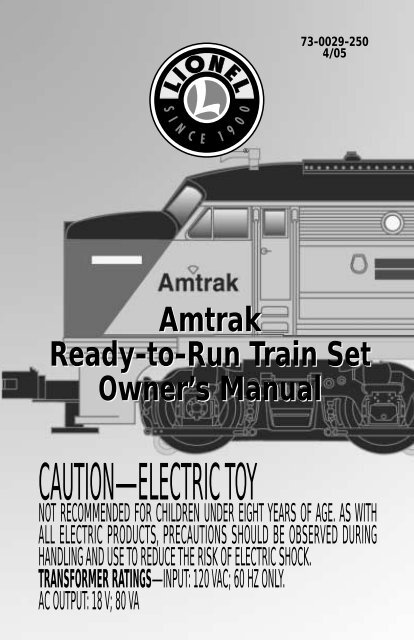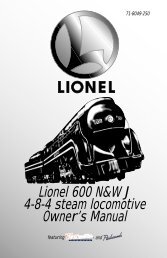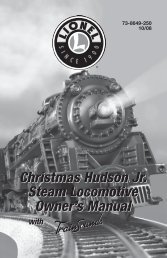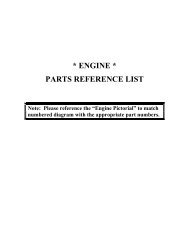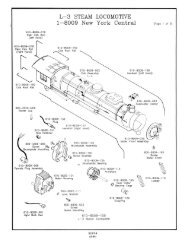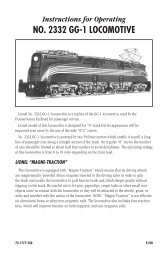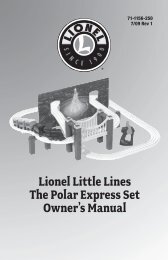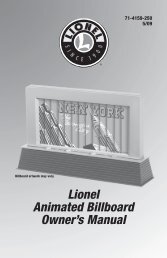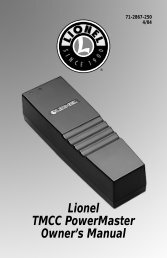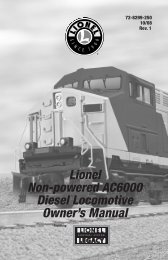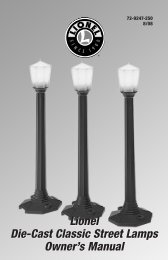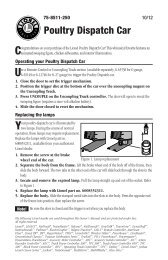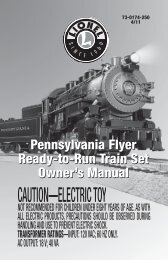Maintaining and servicing your set - Lionel
Maintaining and servicing your set - Lionel
Maintaining and servicing your set - Lionel
Create successful ePaper yourself
Turn your PDF publications into a flip-book with our unique Google optimized e-Paper software.
73-0029-250<br />
4/05<br />
Amtrak<br />
Ready-to-Run Train Set<br />
Owner’s Manual<br />
CAUTION—ELECTRIC TOY<br />
NOT RECOMMENDED FOR CHILDREN UNDER EIGHT YEARS OF AGE. AS WITH<br />
ALL ELECTRIC PRODUCTS, PRECAUTIONS SHOULD BE OBSERVED DURING<br />
HANDLING AND USE TO REDUCE THE RISK OF ELECTRIC SHOCK.<br />
TRANSFORMER RATINGS—INPUT: 120 VAC; 60 HZ ONLY.<br />
AC OUTPUT: 18 V; 80 VA
Congratulations!<br />
Congratulations on <strong>your</strong> purchase of the ready-to-run Amtrak Passenger Train Set! This <strong>set</strong><br />
features everything you need to get started—a mighty CW-80 Transformer, a huge loop of<br />
easy-to-assemble FasTrack track, a string of detailed cars, <strong>and</strong> a powerful <strong>Lionel</strong> locomotive.<br />
Have fun growing with this complete train <strong>set</strong>! Start with the <strong>set</strong> components, then follow<br />
<strong>your</strong> imagination into <strong>your</strong> own miniature world. Exp<strong>and</strong> <strong>your</strong> railroad empire with additional<br />
FasTrack track sections, enhance <strong>your</strong> layout with accessories, lengthen <strong>your</strong> consist with<br />
extra cars, or operate a new locomotive at the head end of <strong>your</strong> train! Explore the possibilities<br />
at <strong>your</strong> authorized <strong>Lionel</strong> dealer.<br />
Use this Owner’s Manual to learn how to <strong>set</strong> up, operate, <strong>and</strong> maintain <strong>your</strong> train <strong>set</strong> for<br />
years of reliable operation.<br />
Amtrak Train Set Features<br />
• Bright headlight<br />
• Electronic diesel horn<br />
• Lighted passenger car interiors<br />
• Operating couplers<br />
Parents!<br />
The transformer included with this <strong>set</strong> should be periodically<br />
examined for conditions that may result in the risk of fire,<br />
electric shock, or injury to persons (such as damage to the<br />
output cord, blades, housing, or other parts). In the event that<br />
such conditions exist, the transformer should not be used until<br />
properly repaired.<br />
The following <strong>Lionel</strong> marks may be used throughout this instruction manual <strong>and</strong> are protected under<br />
law. All rights reserved.<br />
<strong>Lionel</strong> ® , TrainMaster ® , Odyssey ® , RailSounds ® , CrewTalk , TowerCom , DynaChuff ,<br />
StationSounds , Pullmor ® , ElectroCoupler , Magne-Traction ® , CAB-1 ® Remote Controller,<br />
PowerMaster ® , <strong>Lionel</strong> ZW ® , ZW ® , PowerHouse ® , TMCC ® , <strong>Lionel</strong>ville , Lockon ® , Wireless Tether ,<br />
LionMaster ® , American Flyer ® , TrainSounds <br />
The name FasTrack ® is used with permission from Pitsco, Inc.<br />
2
Table of contents<br />
Creating <strong>your</strong> layout<br />
Operating <strong>your</strong> CW-80 Transformer safely 4<br />
Building <strong>your</strong> <strong>Lionel</strong> layout 5<br />
Joining the FasTrack track sections 6<br />
Wiring <strong>your</strong> CW-80 Transformer 7-8<br />
Running <strong>your</strong> train<br />
Running <strong>your</strong> train <strong>set</strong> 9<br />
Coupling 9<br />
Experiencing the features of the CW-80 Transformer 10-11<br />
Reverse unit procedure 12<br />
CW-80 Transformer operation<br />
Powering <strong>your</strong> layout with the CW-80 Transformer 13<br />
Setting the accessory output 14<br />
<strong>Maintaining</strong> <strong>and</strong> <strong>servicing</strong> <strong>your</strong> <strong>set</strong><br />
Lubricating <strong>your</strong> locomotive 15<br />
Replacing <strong>your</strong> locomotive’s traction tire 16<br />
Replacing <strong>your</strong> locomotive’s lamp 16<br />
Replacing the lamp in <strong>your</strong> passenger cars 17<br />
Advanced connections: powering two isolated blocks with two transformers 18<br />
Troubleshooting 19<br />
Limited Warranty/<strong>Lionel</strong> Service 20<br />
Amtrak Train Set Inventory<br />
• FA locomotive<br />
• Two coaches<br />
• Observation car<br />
• CW-80 Transformer with accessory wire<br />
• Three straight FasTrack track sections<br />
• Eight curved FasTrack track sections<br />
• One straight FasTrack terminal track section<br />
• Replacement traction tire<br />
• Owner’s Manual<br />
3
Creating <strong>your</strong> layout<br />
Operating <strong>your</strong> CW-80 Transformer safely<br />
Your <strong>Lionel</strong> CW-80 Transformer is listed by Underwriter’s Laboratory Inc. <strong>and</strong> has been<br />
carefully designed to ensure peak performance. When using electrical products, basic<br />
safety precautions should be maintained.<br />
Be sure to observe the following guidelines:<br />
• Read the manual thoroughly before using this device.<br />
• This device is not recommended for children under eight years of age.<br />
• Parents should periodically inspect this product for potential hazards <strong>and</strong>, if necessary,<br />
have them repaired by an authorized <strong>Lionel</strong> Service Center. In the event that such a condition<br />
exists, the transformer should not be used until it has been properly repaired.<br />
• The CW-80 Transformer is intended to be used indoors. Do not use this device if water is<br />
present. Serious or fatal injuries may result.<br />
• Use the CW-80 Transformer only for its intended purpose.<br />
• The CW-80 Transformer was meant to operate on 120-volt, 60-Hertz power. Do not connect<br />
this product to any other power supply.<br />
• Do not operate the CW-80 Transformer with a damaged cord, plug, or case.<br />
• To avoid the risk of electrical shock, do not disassemble the unit. There are no user serviceable<br />
parts inside. If damaged, take this product to an authorized <strong>Lionel</strong> Service Center. A<br />
list of authorized Service Centers is packed with this unit.<br />
• Do not operate the CW-80 Transformer on <strong>your</strong> layout unattended. Obstructed accessories<br />
or stalled trains may overheat, resulting in damage to <strong>your</strong> layout.<br />
• Always unplug the CW-80 Transformer from the power source when not in use.<br />
• Never insert objects into the ventilation slots on this product. Damage to sensitive<br />
electronic components can result.<br />
4
Creating <strong>your</strong> layout<br />
Building <strong>your</strong> <strong>Lionel</strong> layout<br />
Your <strong>set</strong> comes with eight curved, three straight, <strong>and</strong> one terminal section of track. Figure 1<br />
provides some examples of layouts that you can build with these track sections.<br />
By adding more FasTrack track sections, you can create an endless number of exciting<br />
track arrangements for more fun, action, <strong>and</strong> variety. The railroad empire of <strong>your</strong> dreams can<br />
quickly become a reality!<br />
Figure 1. Track layout ideas<br />
FasTrack Add-on Track Packs make it easy to exp<strong>and</strong> <strong>your</strong> railroad. Each Track Pack<br />
includes all the track sections you need to create a more advanced layout using the sections<br />
included with this <strong>set</strong>. Refer to Figure 2 to explore the possibilities.<br />
Inner Passing Loop Add-on Track Pack<br />
6-12028<br />
Outer Passing Loop Add-on Track Pack<br />
6-12031<br />
Figure 8 Add-on Track Pack<br />
6-12030<br />
Track Packs available separately.<br />
Siding Track Add-on Track Pack<br />
6-12044<br />
Figure 2. Add-on Track Pack layouts<br />
5
Creating <strong>your</strong> layout<br />
Joining the FasTrack track sections<br />
FasTrack track sections join together easily. With interlocking roadbed sections <strong>and</strong> large<br />
rail tabs, the track fits together securely so you always get good electrical contact. Take a<br />
look at Figure 3 to see how to join the track sections.<br />
1. Line up <strong>your</strong> two sections of track.<br />
2. Insert the rail tabs into the openings at the ends of the corresponding<br />
rails.<br />
3. Press the sections together until the interlocking roadbed snaps into<br />
place.<br />
Rail tab<br />
Figure 3. Joining the track sections<br />
6
Creating <strong>your</strong> layout<br />
Wiring <strong>your</strong> CW-80 Transformer<br />
Connect <strong>your</strong> FasTrack terminal section to the CW-80 Transformer. Use the wires that are<br />
already attached to the terminal section. Make sure that all connections are secure. Loose<br />
connections can produce extremely high temperatures. For this reason, do not touch the<br />
terminals or track connections during use. Also, do not locate scenery materials such as<br />
lichen or ground foam near the terminals.<br />
1. Feed the wires through the notch in the FasTrack terminal section. Refer to<br />
Figure 4 on page 8.<br />
2. Loosen the red TRACK thumbscrew terminal, then slide the red<br />
spade-shaped connector into position. The thumbscrew post should be positioned<br />
between the “blades” of the spade connector. Be sure that the blades are touching the<br />
metal post. Tighten the thumbscrew to secure the connection.<br />
3. Loosen the black TRACK thumbscrew terminal, then slide the black<br />
spade-shaped connector into position. Tighten the thumbscrew to secure the<br />
connection. The thumbscrew post should be positioned between the “blades” of the spade<br />
connector. Be sure that the blades are touching the metal post.<br />
4. If you need to power an accessory (available separately at <strong>your</strong><br />
authorized <strong>Lionel</strong> dealer), connect the accessory to the ACCESSORY<br />
thumbscrew terminals. Use the accessory wire included with the CW-80 Transformer.<br />
5. Plug the CW-80 Transformer into <strong>your</strong> wall outlet (120 volts).<br />
As <strong>your</strong> layout exp<strong>and</strong>s, you may also make power connections with the stripped ends of<br />
wires, placing no more than two wires on each terminal. For best performance on large<br />
layouts, it is recommended that you use 16-gauge wire to connect <strong>your</strong> CW-80 Transformer to<br />
the track. On larger layouts where several track connections are required, the use of separate<br />
junctions/terminal strips (available at <strong>your</strong> local electronics store) is recommended to<br />
prevent voltage drops.<br />
Caution! To prevent the excessive build up of heat, be sure to select the proper wire gauge<br />
for <strong>your</strong> layout. Follow these guidelines:<br />
• Track connections must be made with 18-gauge wire or heavier. Larger<br />
layouts require a minimum of 16-gauge wire.<br />
• Use 24-gauge wire only when connecting single accessories that require lower<br />
current.<br />
• When wiring multiple accessories (two or more) or accessories that require<br />
higher current, be sure to use 18- to 16-gauge wire.<br />
7
Creating <strong>your</strong> layout<br />
Wiring <strong>your</strong> CW-80 Transformer (continued)<br />
FasTrack terminal section<br />
Spade-shaped<br />
connector<br />
TRACK<br />
ACCESSORY<br />
A<br />
B<br />
U<br />
U<br />
120/60z<br />
0~18VAC<br />
0~18VAC<br />
Notch<br />
Figure 4. Controller connections<br />
8
Running <strong>your</strong> train<br />
Running <strong>your</strong> train <strong>set</strong><br />
1<br />
32<br />
3<br />
With track power off, place <strong>your</strong> train <strong>set</strong> on the track.<br />
Refer to the following section for information on coupling the cars.<br />
Power up <strong>your</strong> locomotive with <strong>your</strong> transformer.<br />
Your locomotive is designed to operate on 7-15 volts alternating current.<br />
Virtually all <strong>Lionel</strong> <strong>and</strong> <strong>Lionel</strong>-compatible alternating-current transformers<br />
are suitable.<br />
Note! Do not power <strong>your</strong> locomotive with direct-current (DC) transformers.<br />
The locomotive was designed for use with alternating-current (AC)<br />
transformers only.<br />
Move ‘em out!<br />
Get <strong>your</strong> locomotive moving. Your locomotive goes through a repeating pattern<br />
of operations: forward, neutral, reverse, neutral, <strong>and</strong> so on. To sequence the reverse<br />
unit, press the DIRECTION button on <strong>your</strong> transformer, or briefly bring the throttle<br />
all the way back to the OFF position <strong>and</strong> then forward. Each press of the DIRECTION<br />
button or interruption in track power causes the locomotive to advance to the next<br />
operational state.<br />
Adjust track voltage until <strong>your</strong> locomotive moves at <strong>your</strong> desired speed.<br />
Coupling<br />
When coupling <strong>your</strong> cars, at least one of the mating couplers must be open as shown at the left<br />
in Figure 5. Press down on the lock release to open the coupler, then push the cars toward<br />
each other until they lock together.<br />
Note!<br />
Keep in mind that it’s easier to couple cars on a straight stretch of track.<br />
Lock release<br />
Figure 5. Coupler operation<br />
9
Running <strong>your</strong> train<br />
Experiencing the features of the CW-80 Transformer<br />
Refer to Figure 6 on page 11 for the location of the Transformer features listed in this section.<br />
THROTTLE<br />
Push the throttle forward to increase track power. The markings on the throttle approximate<br />
the percentage of full power. For more realism, push the throttle slowly to gradually<br />
increase or decrease the speed of the locomotive. Slowing or stopping the locomotive with the<br />
throttle instead of the DIRECTION button will allow you to continue in the same direction<br />
when you increase the throttle again. To achieve this effect, reduce the throttle to the point<br />
that the locomotive stops moving, but don’t completely turn off the throttle. That way, <strong>your</strong><br />
train won’t sequence into neutral.<br />
DIRECTION<br />
The DIRECTION control button interrupts track power to activate the reverse unit in <strong>your</strong><br />
locomotive. Your locomotive will not respond to this button when the reverse unit switch is in<br />
the OFF position.<br />
WHISTLE<br />
The WHISTLE button will activate <strong>your</strong> locomotive’s horn. The sound will continue until<br />
the button is released. No external sound activation buttons are needed.<br />
BELL<br />
The BELL button will activate the bell sounds on locomotives equipped with this feature. Press<br />
<strong>and</strong> hold the BELL button for two to three seconds to begin the sounds; press <strong>and</strong> hold the button<br />
again to turn off the ringing.<br />
Note! Your locomotive is not equipped with bell sounds. Do not activate horns, whistles, or<br />
bells on TrainSounds-equipped locomotives until track power has been turned on<br />
for a few moments, or a continuous horn/whistle or bell sound may occur. To correct<br />
this problem, simply turn off the CW-80 Transformer, then turn it back on.<br />
POWER-ON INDICATOR<br />
The green light will remain on during normal operation. The green light will begin to<br />
flash if you exceed the power limit of the Transformer. The unit will allow you to momentarily<br />
exceed the power limit, but power will be gradually reduced until the problem is corrected.<br />
The benefit is that the Transformer will not instantly turn off.<br />
10
Running <strong>your</strong> train<br />
Experiencing the features of the CW-80 Transformer<br />
(continued)<br />
Power-on indicator<br />
The green light<br />
illuminates when the<br />
CW-80 is on.<br />
Direction<br />
Press the DIRECTION button to go forward<br />
or reverse, or to place the locomotive in<br />
neutral (no movement, headlight is on).<br />
Bell<br />
Starts or stops the tolling bell in any<br />
locomotive equipped with this feature.<br />
Press BELL to begin the sound,<br />
again to stop it.<br />
Whistle<br />
Activates the whistle or horn sound<br />
effect in <strong>your</strong> <strong>Lionel</strong> locomotives.<br />
Press WHISTLE to begin the sound;<br />
release the button to end it.<br />
Figure 6. Transformer features<br />
Throttle<br />
Controls <strong>your</strong> locomotive’s speed. Throw the throttle forward<br />
to increase locomotive speed, backward to slow it<br />
down.<br />
11
Running <strong>your</strong> train<br />
Reverse unit procedure<br />
The electronic reverse unit inside <strong>your</strong> <strong>Lionel</strong> locomotive acts like the transmission in a car.<br />
When you apply power to the track, the locomotive moves in the direction specified by the<br />
reverse unit—or it sits in neutral, awaiting another power interruption. Power interruptions<br />
are the signal that tells the reverse unit to sequence to the next operational state.<br />
To interrupt power <strong>and</strong> sequence the locomotive’s reverse unit, press the direction control<br />
button or briefly bring the throttle lever all the way back to the OFF position. Refer to Figure 6<br />
on page 11 for the location of these controls. The reverse unit alternates between three states:<br />
forward, neutral, <strong>and</strong> reverse.<br />
Also, the locomotive can be “locked” into a certain mode of operation by throwing the<br />
reverse unit switch located on the underside of the frame (see Figure 7). To lock <strong>your</strong> locomotive<br />
into a specific operational state, sequence the locomotive into the desired state <strong>and</strong> reduce<br />
track power without completely powering down the locomotive, then throw the switch to the<br />
OFF position. The DIRECTION button will then have no affect on the direction of the locomotive.<br />
If you would like to resume forward-neutral-reverse operation, simply throw the reverse<br />
unit switch back to the ON position.<br />
Additionally, this reverse unit has a “power-up re<strong>set</strong>” feature. If the locomotive sits without<br />
power for a short period of time, the reverse unit will automatically re<strong>set</strong> <strong>and</strong> start in the forward<br />
direction when the transformer is turned on or “powered up,” regardless of the reverse unit<br />
switch position. If the switch is in the OFF position, the locomotive will start in the forward direction<br />
<strong>and</strong> be “locked” there.<br />
REAR<br />
Underside of the<br />
locomotive<br />
Reverse unit switch<br />
Figure 7. Switch location<br />
12
CW-80 Transformer operation<br />
Powering <strong>your</strong> layout with the CW-80 Transformer<br />
Your CW-80 Transformer provides a total output of five amps. The track outputs will deliver<br />
all of this power to the track when no accessories are connected to the Transformer. Keep<br />
in mind that connected accessories borrow some of this power. For example, if the accessories<br />
require two amps of the total five-amp capacity of the Transformer, you have three amps available<br />
for track power. This built-in flexibility will provide power for virtually any small- to<br />
medium-sized railroad. Also, available voltage depends on how much load is on the two outputs.<br />
Generally, track voltage <strong>and</strong> accessory voltage are 0-18 volts (AC) each.<br />
This Transformer is capable of operating trains up to <strong>and</strong> including dual-motored AC<br />
locomotives. To operate at this level of track power, it may be necessary to disconnect any<br />
accessories. You may also attempt to lower the accessory voltage <strong>set</strong>tings. Refer to the “Setting<br />
the accessory output” section on page 14.<br />
You may momentarily approach or exceed the five-amp limit of the CW-80 Transformer<br />
when pulling illuminated cars, fighting over grades with heavy loads, or operating accessories.<br />
When you reach five amps, the green light on the Transformer will begin to flash. This indicates<br />
that the Transformer is in “fold-back mode.” In fold-back mode, the Transformer is<br />
automatically reducing, or folding back, power. This gradual reduction in power provides<br />
interruption-free operation while you bring the amperage back down to a safe level.<br />
13
CW-80 Transformer operation<br />
Setting the accessory output<br />
<strong>Lionel</strong> offers accessories of all shapes <strong>and</strong> sizes — from crossing signals to coal <strong>and</strong> lumber<br />
loaders — available at <strong>your</strong> authorized <strong>Lionel</strong> dealer. When you are ready to operate <strong>your</strong><br />
new accessory, the CW-80 Transformer allows you to choose how much power <strong>your</strong> accessory<br />
receives with programmable accessory output. The ability to control the voltage allows you to<br />
<strong>set</strong> the speed of <strong>your</strong> accessory motors <strong>and</strong> the intensity of <strong>your</strong> lights. Accessories connected to<br />
the accessory output terminals receive constant voltage whenever the transformer is plugged<br />
in, regardless of the throttle position. Follow these steps to <strong>set</strong> the voltage.<br />
Note! The accessory output voltage was <strong>set</strong> to 12 volts at the factory.<br />
1. Connect <strong>your</strong> accessory to the CW-80 Transformer as discussed on page 7.<br />
2. Bring the throttle all the way back to the OFF position.<br />
3. Press <strong>and</strong> hold down the DIRECTION, WHISTLE, <strong>and</strong> BELL buttons on the<br />
transformer. Refer to Figure 6 on page 11 for the location of these buttons.<br />
The green light on the Transformer will flash, <strong>and</strong> track power will turn off.<br />
4. With all three buttons held down, raise the throttle slowly until you reach<br />
<strong>your</strong> desired accessory voltage.<br />
5. Release the buttons once you have reached <strong>your</strong> desired voltage.<br />
The accessory turns off, <strong>and</strong> the solid green light indicates that you have <strong>set</strong> the accessory<br />
voltage.<br />
6. Bring the throttle all the way back to turn off the power.<br />
The voltage will momentarily increase, briefly causing the lights to shine brighter or the<br />
motors to operate faster, before returning to the <strong>set</strong> level. At this point, increasing the throttle<br />
again will control track power only.<br />
14
<strong>Maintaining</strong> <strong>and</strong> <strong>servicing</strong> <strong>your</strong> <strong>set</strong><br />
Lubricating <strong>your</strong> locomotive<br />
Help <strong>your</strong> <strong>Lionel</strong> locomotive lead a long <strong>and</strong> productive life on <strong>your</strong> railroad by maintaining<br />
it properly.<br />
We recommend that you purchase a <strong>Lionel</strong> Lubrication <strong>and</strong> Maintenance Kit (6-62927),<br />
available from <strong>your</strong> <strong>Lionel</strong> dealer. Two basic rules to keep in mind: never over-lubricate (a<br />
small amount will do), <strong>and</strong> avoid getting grease or oil on the locomotive’s wheels, contact<br />
rollers, or <strong>your</strong> track.<br />
You’ll know <strong>your</strong> locomotive requires lubrication when visual inspection reveals dryness on<br />
the parts indicated in Figure 8. Remove accumulated dirt <strong>and</strong> dust before lubricating, <strong>and</strong><br />
always lubricate any locomotive emerging from prolonged storage.<br />
Lubricate gears with<br />
<strong>Lionel</strong> grease<br />
sparingly<br />
Lubricate axle ends<br />
with <strong>Lionel</strong> oil<br />
sparingly<br />
Lubricate axle ends<br />
with <strong>Lionel</strong> oil<br />
sparingly<br />
Figure 8. Lubrication points<br />
15
<strong>Maintaining</strong> <strong>and</strong> <strong>servicing</strong> <strong>your</strong> <strong>set</strong><br />
Replacing <strong>your</strong> locomotive’s traction tire<br />
Your locomotive is equipped with four traction tires, <strong>Lionel</strong> part no. 620-8530-206. These<br />
rubber tires increase the tractive effort of <strong>your</strong> locomotive, allowing it to pull more cars at<br />
once. During the course of normal operations, the traction tires may become worn out.<br />
Because you must remove the trucks <strong>and</strong> the side frames to access the wheels, we recommend<br />
that you have the traction tires replaced by <strong>your</strong> authorized <strong>Lionel</strong> Service Center.<br />
Replacing <strong>your</strong> locomotive’s lamp<br />
Your locomotive lights the way with its operating headlight. During the course of normal<br />
operation, the lamp may require replacement. Refer to Figure 9 as you replace the lamp.<br />
1. Remove the body screw from the rear of the locomotive.<br />
2. Disengage the body from the tab on front of the frame <strong>and</strong> lift away the body.<br />
3. Pull the lamp straight out <strong>and</strong> replace it with <strong>Lionel</strong> part no. 600-0161-300, available from<br />
<strong>your</strong> authorized <strong>Lionel</strong> Service Center or from <strong>Lionel</strong> Service. Be careful not to twist the<br />
lamp, or it may break.<br />
4. Replace the body on the frame, inserting the tab into the slot on the front of the locomotive.<br />
5. Replace the body screw to secure the body to the frame.<br />
<strong>Lionel</strong> part no. 600-0161-300<br />
Lamp housing<br />
Figure 9. Headlight replacement<br />
16
<strong>Maintaining</strong> <strong>and</strong> <strong>servicing</strong> <strong>your</strong> <strong>set</strong><br />
Replacing the lamp in <strong>your</strong> passenger cars<br />
Each car car is illuminated by two 12-volt lamps (part no. 600-8352-310). During the<br />
course of normal operations, the lamps may require replacement. To replace a lamp inside<br />
the car, remove the two screws from the underside of the frame. See Figure 10. Once these<br />
screws are removed, you can lift off the roof, remove the expired lamp, <strong>and</strong> then install the<br />
replacement. Replace the roof <strong>and</strong> the two screws on the underside of the frame.<br />
<strong>Lionel</strong> part no. 600-8352-310<br />
Figure 10. Lamp replacement<br />
17
<strong>Maintaining</strong> <strong>and</strong> <strong>servicing</strong> <strong>your</strong> <strong>set</strong><br />
Advanced connections: powering two isolated blocks with two<br />
transformers<br />
As you exp<strong>and</strong> <strong>your</strong> layout, you may decide to create<br />
two isolated blocks of track. Trains in each block<br />
are controlled by separate transformers.<br />
Before you operate <strong>your</strong> trains on this type of layout,<br />
be sure that <strong>your</strong> transformers are in phase. Operating<br />
<strong>your</strong> trains on a layout with two transformers that are<br />
out of phase may cause damage to the locomotive’s sensitive<br />
electronic components.<br />
To be certain that <strong>your</strong> transformers are in phase, use<br />
a small 18-volt lamp with leads (available at <strong>your</strong> local<br />
electronics supply store) to perform a quick test. Refer to<br />
Figure 11.<br />
Figure 11. Testing for proper phasing<br />
1. Attach one lamp wire to the center rail in one block.<br />
2. Attach the second lamp wire to the center rail in the other block.<br />
3. Power up both blocks of track. Both transformers should be <strong>set</strong> to full power.<br />
4. See if the lamp illuminates.<br />
If the lamp illuminates brightly, <strong>your</strong> transformers are not in phase. Do not operate <strong>your</strong><br />
trains on the layout until you change the wiring. If the lamp does not illuminate or the lamp<br />
is dim, <strong>your</strong> transformers are in phase <strong>and</strong> should not cause problems.<br />
To bring <strong>your</strong> transformers into phase, simply swap the track wires at the A <strong>and</strong> U terminals<br />
on one of the transformers. If you are using an older transformer that lacks a polarized plug,<br />
you may reverse the plug at the outlet so that the prongs are inserted into the opposite<br />
openings. Repeat the procedure described above, <strong>and</strong> you should find that the lamp does not<br />
illuminate or the lamp is dim.<br />
Note!<br />
This will also reverse the operation of the BELL <strong>and</strong> WHISTLE buttons on the<br />
transformer with the switched wires.<br />
18
<strong>Maintaining</strong> <strong>and</strong> <strong>servicing</strong> <strong>your</strong> <strong>set</strong><br />
Troubleshooting<br />
No lights or operation<br />
Be sure that the CW-80 Transformer is plugged in <strong>and</strong> the wires are connected.<br />
Train runs, but WHISTLE, BELL, <strong>and</strong> DIRECTION buttons do not work<br />
Check track connections. The track must be connected to the “A” <strong>and</strong> “U” terminals on the<br />
Transformer.<br />
No change when DIRECTION button is pressed<br />
Be sure that <strong>your</strong> locomotive’s reverse unit switch is ON.<br />
Accessory operation is intermittent or absent<br />
Check for loose, shorted, or improper connections. Also, the accessory voltage may have been<br />
<strong>set</strong> too low for the accessory; refer to page 14 <strong>and</strong> re<strong>set</strong> the voltage to a higher level.<br />
Locomotive runs slowly or lights dim at the far end of the track<br />
On larger layouts, additional track resistance may cause reduced track voltage as the trains<br />
move away from the power terminal section. Install additional FasTrack terminal sections<br />
around <strong>your</strong> layout <strong>and</strong> connect them to <strong>your</strong> Transformer to distribute power.<br />
Green light begins to flash<br />
The power limit of the Transformer has been exceeded. The unit will gradually reduce power<br />
until the problem is corrected.<br />
Bell button blows whistle<br />
Switch the wire connections at the Transformer terminals. The U terminal should be connected<br />
to the outside (common) rail.<br />
19
Limited Warranty/<strong>Lionel</strong> Service<br />
This <strong>Lionel</strong> product, including all mechanical <strong>and</strong> electrical components, moving parts, motors <strong>and</strong><br />
structural components, except for light bulbs, is warranted to the original consumer-purchaser, for one<br />
year against original defects in materials or workmanship when purchased through an authorized <strong>Lionel</strong><br />
merchant.<br />
This warranty does NOT cover normal wear <strong>and</strong> tear, light bulbs, defects appearing in the course of<br />
commercial use, or damage resulting from abuse or misuse of the product by the purchaser. Transfer of this<br />
product by the original consumer-purchaser to another person voids this warranty. Modification of this<br />
product voids this warranty.<br />
Any warranted product which is defective in original materials or workmanship <strong>and</strong> is delivered by the<br />
original consumer-purchaser to <strong>Lionel</strong> L.L.C. or an authorized <strong>Lionel</strong> L.L.C. Service Center, together with proof<br />
of original purchase will, at the option of <strong>Lionel</strong> L.L.C., be repaired or replaced, without charge for parts or<br />
labor. In the event the defective product cannot be repaired, <strong>and</strong> a replacement is not available, a refund of the<br />
original purchase price will be granted. Any products on which warranty service is sought must be sent freight<br />
or postage prepaid, as transportation <strong>and</strong> shipping charges are not covered by the warranty.<br />
In no event shall <strong>Lionel</strong> L.L.C. be liable for incidental or consequential damages.<br />
Some states do not allow the exclusion or limitation of incidental or consequential damages, so the above<br />
exclusion may not apply to you.<br />
This limited warranty gives you specific legal rights, <strong>and</strong> you may have other rights which vary from state<br />
to state.<br />
Instructions for Obtaining Service<br />
If service for this <strong>Lionel</strong> L.L.C. product is required, bring the item, along with <strong>your</strong> dated sales receipt <strong>and</strong><br />
completed warranty information to the nearest Authorized <strong>Lionel</strong> Service Center. Your nearest <strong>Lionel</strong> Service<br />
Center can be found by calling 1-800-4-<strong>Lionel</strong>, or by accessing our Website at www.lionel.com.<br />
If you prefer to send <strong>your</strong> product back to <strong>Lionel</strong> L.L.C. for repair in Michigan, you must first call<br />
586-949-4100 or FAX 586-949-5429, or write to Customer Service, P.O. Box 748, New Baltimore, MI<br />
48047-0748, stating what the item is, when it was purchased <strong>and</strong> what seems to be the problem. You will be<br />
sent a return authorization letter <strong>and</strong> label to ensure <strong>your</strong> merch<strong>and</strong>ise will be properly h<strong>and</strong>led upon receipt.<br />
Once you have received <strong>your</strong> return authorization <strong>and</strong> label, make sure that the item is packed to prevent<br />
damage during shipping <strong>and</strong> h<strong>and</strong>ling. We suggest that you use the product’s original packaging. This<br />
shipment must be prepaid <strong>and</strong> we recommend that it be insured.<br />
Please make sure you have followed all of the above instructions carefully before returning any<br />
merch<strong>and</strong>ise for service. You may choose to have <strong>your</strong> product repaired by one of our Authorized <strong>Lionel</strong><br />
Service Centers after its warranty has expired. A reasonable service fee will be charged.<br />
Warranty Information<br />
Please complete the information below <strong>and</strong> keep it, along with <strong>your</strong> dated sales receipt. You must present<br />
this <strong>and</strong> <strong>your</strong> dated sales receipt when requesting warranty service.<br />
Name ________________________________________________________________________<br />
Address<br />
______________________________________________________________________<br />
Place of Purchase ________________________________________________________________<br />
Date of Purchase<br />
Product Number<br />
________________________________________________________________<br />
________________________________________________________________<br />
Product Description<br />
______________________________________________________________<br />
©2005 LIONEL L.L.C., CHESTERFIELD, MI 48051-2493<br />
UNITED STATES OF AMERICA<br />
PRINTED IN CHINA


